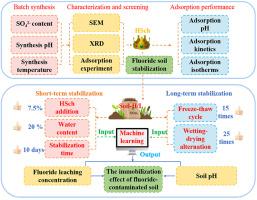优化合成施韦特曼石对氟化物污染土壤的新型高性能稳定
IF 10
1区 环境科学与生态学
Q1 ENGINEERING, ENVIRONMENTAL
引用次数: 0
摘要
土壤氟污染被认为是一个严重的环境问题。Schwertmannite (Sch)具有独特的结构特性和高效的氟吸附性能。合成条件对其结构和吸附性能有显著影响。然而,合成条件-结构-氟吸附性能之间的关系尚未研究。本文通过调节合成条件(67.96 mg/g),在SO42−含量为1.5倍、pH = 2.5、温度为15℃条件下合成了吸附量最高的HSch。通过机器学习(ML),合成pH(52%)是影响吸附Sch性能的主要因素。本研究首先将HSch应用于高(Soil-H)和低(Soil-L)浓度的氟污染土壤,并对HSch的短期稳定和长期稳定(冻融循环、干湿交替)效果进行了评价。添加HSch对降低氟浸出浓度的效果最为显著。稳定时间对土壤- h的pH影响最大(40%),而添加HSch对土壤- l的pH影响最大(45%)。与冻融循环相比,增加干湿交替对土壤h和土壤l中氟离子的固定化作用更为显著(分别为70%和74%)。此外,本研究还揭示了HSch对氟的吸附是一个以单层吸附为特征的化学吸附过程。这个过程主要涉及表面oh基团的解离,释放H+离子。这些H+离子在soil -H和soil - l中与OH -发生反应,降低了土壤pH。pH的降低促进了HF与SO42 -的反应,从而增强了氟的固定作用。本研究为Sch在氟化物污染土壤修复中的应用提供了战略见解。本文章由计算机程序翻译,如有差异,请以英文原文为准。

Optimizing synthetic schwertmannite for novel high-performance stabilization of fluoride contaminated soils
Soil fluoride contamination is considered a severe environmental problem. Schwertmannite (Sch) has unique structural properties and is highly efficient in fluoride adsorption. The synthesizing conditions of Sch can significantly influence its structure and adsorption properties. However, the relationship between Sch synthesis conditions-structure-fluoride adsorption performance has not been investigated. In this paper, we synthesized the HSch with the highest adsorption capacity at 1.5 times SO42− content, pH = 2.5, and 15 °C by modulating the synthesis conditions (67.96 mg/g). The synthesis pH (52 %) was the main factor affecting the adsorption performance of Sch by using machine learning (ML). In this study, HSch was firstly applied to both high (Soil-H) and low (Soil-L) concentration fluoride contaminated soils, and the short-term stabilization and long-term stabilization (freeze-thaw cycles, wetting-drying alternation) effect of HSch was assessed. HSch addition had the most pronounced effect on reducing fluoride leaching concentration. Stabilization time had the greatest impact on the pH of Soil-H (40 %), while the HSch addition had the greatest impact on the pH of Soil-L (45 %). Compared with freeze-thaw cycles, the increase in wetting-drying alternations had a more significant effect on the immobilization of fluoride ions in Soil-H and Soil-L by Sch (70 % and 74 %, respectively). Additionally, this study revealed that the fluoride adsorption by HSch is a chemisorption process characterized by monolayer adsorption. This process primarily involves the dissociation of surface-OH groups, releasing H+ ions. These H+ ions react with OH− in Soil-H and Soil-L, lowering the soil pH. The reduced pH promotes the reaction between HF and SO42−, thereby enhancing fluoride immobilization. This study provides strategic insights into the application of Sch for the remediation of fluoride-contaminated soils.
求助全文
通过发布文献求助,成功后即可免费获取论文全文。
去求助
来源期刊

Journal of Cleaner Production
环境科学-工程:环境
CiteScore
20.40
自引率
9.00%
发文量
4720
审稿时长
111 days
期刊介绍:
The Journal of Cleaner Production is an international, transdisciplinary journal that addresses and discusses theoretical and practical Cleaner Production, Environmental, and Sustainability issues. It aims to help societies become more sustainable by focusing on the concept of 'Cleaner Production', which aims at preventing waste production and increasing efficiencies in energy, water, resources, and human capital use. The journal serves as a platform for corporations, governments, education institutions, regions, and societies to engage in discussions and research related to Cleaner Production, environmental, and sustainability practices.
 求助内容:
求助内容: 应助结果提醒方式:
应助结果提醒方式:


